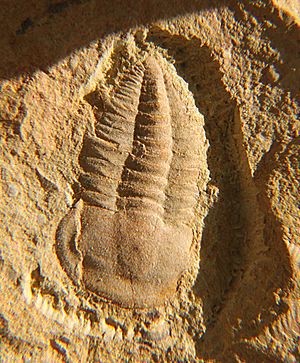Yunnanocephalus facts for kids
Quick facts for kids Yunnanocephalus |
|
|---|---|
 |
|
| Yunnanocephalus yunnanensis, 18 mm (0.71 in) | |
| Scientific classification |
|
| Kingdom: | Animalia |
| Phylum: | Arthropoda |
| Class: | †Trilobita |
| Order: | †Ptychopariida |
| Family: | †Yunnanocephalidae Hupé, 1953 |
| Genus: | †Yunnanocephalus Kobayashi, 1936 |
| Type species | |
| Ptychoparia yunnanensis |
|
| Species | |
|
|
| Synonyms | |
|
|
Yunnanocephalus is a type of ancient sea creature called a trilobite. Trilobites were small animals with hard shells that lived in the ocean a very long time ago. Yunnanocephalus lived during the Cambrian Period, about 522 to 510 million years ago.
These fascinating creatures could be found in areas that are now Antarctica, Australia, and China. Yunnanocephalus was a common member of the Chengjiang Fauna, which is a famous collection of fossils from China. It is the only known member of its family, the Yunnanocephalidae.
Contents
What Did Yunnanocephalus Look Like?
Yunnanocephalus was a small trilobite, usually about 2 centimetres or 0.79 inches long. That's about the size of a small paperclip! Its body had an oval shape, wider at the front and narrower at the back.
Its Head and Body
The headshield, also called the cephalon, was oval-shaped. It was about twice as wide as it was long. The central raised part of the head, called the glabella, was not very clear. It tapered towards the front.
Yunnanocephalus had small eyes, which were about 20% of the length of its head. The lines on its head, called sutures, helped it shed its shell as it grew.
Its Middle and Tail
The middle part of its body, called the thorax, had 14 segments. These segments had short, pointy spines. The third and fourth segments were a bit wider than the ones in front.
At the very end, it had a small tailshield, known as the pygidium. This tail was mostly made up of a central part with two faint rings.
How Yunnanocephalus Grew
Just like many animals, Yunnanocephalus changed as it grew from a young stage to an adult. This process is called ontogeny.
Changes in Its Face
Scientists have studied how Yunnanocephalus yunnanensis developed. They found that the lines on its face, called facial sutures, changed their shape. When it was a young larva (called a meraspis), its sutures were different from when it became an adult (called a holaspis).
This kind of change is quite rare in trilobites. Usually, trilobites that have one type of suture as adults started with a different type as larvae.
Where Did Yunnanocephalus Live?
Fossils of Yunnanocephalus have been found in different parts of the world, showing how widespread these creatures once were.
- In Antarctica: Yunnanocephalus longioccipitalis fossils were found in the Shackleton Limestone. This rock formation dates back to the Atdabanian stage of the Lower Cambrian period.
- In Australia: Yunnanocephalus macromelos was discovered in the Mernmerna Formation in South Australia. These fossils are from the Botomian stage of the Lower Cambrian.
- In China: Yunnanocephalus yunnanensis fossils are quite common in China. They have been found in the Yuanshan or Qiongzhusi Formation, especially near the famous Chengjiang biota sites in Yunnan province. These fossils are also from the Atdabanian stage.

